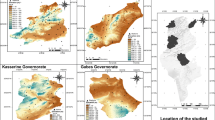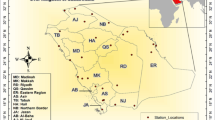Abstract
The impacts of floods and droughts are intensified by climate change, lack of preparedness, and coordination. The average rainfall in study area is ranging from 200 to 400 mm per year. Rain gauge generally provides very accurate measurement of point rain rates and the amounts of rainfall but due to scarcity of the gauge locations provides very general information of the area on regional scale. Recognizing these practical limitations, it is essential to use remote sensing techniques for measuring the quantity of rainfall in the Middle Indus. In this research, Tropical Rainfall Measuring Mission (TRMM) estimation can be used as a proxy for the magnitude of rainfall estimates from classical methods (rain gauge), quantity, and its spatial distribution for Middle Indus river basin. In order to use TRMM satellite data for discharge measurement, its accuracy is determined by statistically comparing it with in situ gauged data on daily and monthly bases. The daily R 2 value (0.42) is significantly lower than monthly R 2 value (0.82), probably due to the time of summation of TRMM 3-hourly precipitation data into daily estimates. Daily TRMM data from 2003 to 2012 was used as input forcing in Soil and Water Assessment Tool (SWAT) hydrological model along with other input parameters. The calibration and validation results of SWAT model give R 2 = 0.72 and 0.73 and Nash-Sutcliffe coefficient of efficiency = 0.69 and 0.65, respectively. Daily and monthly comparison graphs are generated on the basis of model discharge output and observed data.








Similar content being viewed by others
References
Center EO (2001) TRMM data users handbook. National Space Development Agency of Japan
Han W (2010) Analysis of satellite rainfall data and global runoff process to improve global runoff modeling (Doctoral dissertation, The University of Utah)
Islam M, Uyeda H (2008) Vertical variations of rain intensity in different rainy periods in and around Bangladesh derived from TRMM observations. Int J Climatol 28(2):273–279
Kneis D, Chatterjee C, Singh R (2014) Evaluation of TRMM rainfall estimates over a large Indian river basin (Mahanadi). Hydrol Earth Syst Sci 18(7):2493–2502
Kumar D, Pandey A, Sharma N, Flügel WA (2015) Evaluation of TRMM-precipitation with rain-gauge observation using hydrological model J2000. J Hydrol Eng E5015007
Li XH, Zhang Q, Xu CY (2012) Suitability of the TRMM satellite rainfalls in driving a distributed hydrological model for water balance computations in Xinjiang catchment, Poyang lake basin. J Hydrol 426:28–38
Liu XC, Gao TC, Liu L (2013) A comparison of rainfall measurements from multiple instruments. Atmos Meas Tech 6(7):1585–1595
Nash JE, Sutcliffe JV (1970) River flow forecasting through conceptual models part I—a discussion of principles. J Hydrol 10(3):282–290
Nystuen JA (1999) Relative performance of automatic rain gauges under different rainfall conditions. J Atmos Ocean Technol 16(8):1025–1043
Peña-Arancibia JL, van Dijk AI, Renzullo LJ, Mulligan M (2013) Evaluation of precipitation estimation accuracy in reanalyses, satellite products, and an ensemble method for regions in Australia and South and East Asia. J Hydrometeorol 14(4):1323–1333
Santhi C, Arnold JG, Williams JR, Dugas WA, Srinivasan R, Hauck LM (2001) Validation of the swat model on a large RWER basin with point and nonpoint sources1
Saw BL (2005) Infrared and passive microwave satellite rainfall estimate over tropics (Doctoral dissertation, University of Missouri-Columbia)
Younis SMZ, Iqbal J (2015) Estimation of soil moisture using multispectral and FTIR techniques. Egypt J Remote Sens Space Sci 18(2):151–161
Zhou T, Yu R, Chen H, Dai A, Pan Y (2008) Summer precipitation frequency, intensity, and diurnal cycle over China: a comparison of satellite data with rain gauge observations. J Clim 21(16):3997–4010
Author information
Authors and Affiliations
Corresponding author
Rights and permissions
About this article
Cite this article
Younis, S.M.Z., Majid, M. & Ammar, A. Satellite-based rainfall estimation and discharge measurement of Middle Indus River, Pakistan. Arab J Geosci 10, 404 (2017). https://doi.org/10.1007/s12517-017-3192-9
Received:
Accepted:
Published:
DOI: https://doi.org/10.1007/s12517-017-3192-9




